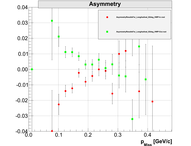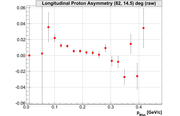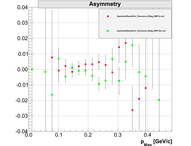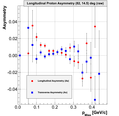3He(e,e'd) Asymmetries
What is new?
1.) Analyzed all (vast majority) of 2GeV data.
I have now on my computer rootfiles of 961 production runs. Now I can
determine asymmetries for all kinematics. This is work in progress.
2.) Calculated transverse/longitudinal asymmetries for 82deg setting
I have calculated asymmetries for the kinematic setting when BB was at
-82deg and HRSL at 14.5deg. Here are the results. (Q**2 = 0.33 GeV^2)
Longitudinal asymmetries:
1.)  2.)
2.) 
Transverse asymmetries:
3.)  4.)
4.) 
Rotated asymmetries:
5.)  6.)
6.) 
3.) Analyzing asymmetries for 12.5deg setting:
I am in progress of calculating asymmetries when BB was at -75deg and
HRSL at 12.5deg. This is work in progress Here are the results
for the Longitudinally polarized target.
7.) 
Finished checking target orientation signal
I went through all the target settings and check if the
spin signal given by Analyzer agrees with the true orientation of
the target. Will report on this next week.
ZLIB problem
I am still having problems with the crashing of the analysis, due
to the ZLIB problem. Until recently I though that runs, that first
crash but later automatically recover, are good. However, I realized that in
some cases I get strange results even if only run is bad. Please see
figures below.
8.)  9.)
9.) 
Left figure shows results that I got when I considered run #3229, that
crashed in the middle of the analysis (but eventually came successful
to the end). You can see how point at p_miss=0.14GeV is moved to higher
value. This happens because of this bad analysis of the run #3229.
Later I reanalyzed this run, this time without any errors and got
completely different results. This brings important message, that
this problem can not be swiped under the rug
Therefore I went into the analyzer code and realized that by default
level 1 compression is being used, which considers Lempel-Ziv-Markov
compression algorithm. I set the compression level to zero and restarted
the analysis on FARM. I will let you know what happens next week.
Checked my algorithm for the rotation of the asymmetries
I have also checked algorithm, that I used to rotate asymmetries
from LAB coordinate-system to the "q-CS". I believe that my code
was correct. I also believe that asymmetries that I showed you
last week should be the same at low p_miss, with the same sign.
When looking at the elastic proton asymmetries at the same Q**2,
one can see that these asymmetries (A_perp, A_par) at given Q^2
should be approx. of the same size. I will show you more detailed results
next week.
Last modified: 09/28/11
 2.)
2.) 
 4.)
4.) 
 6.)
6.) 

 9.)
9.) 